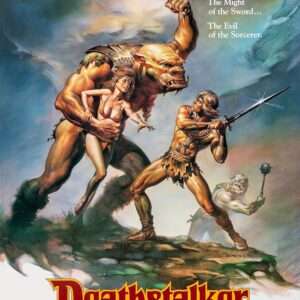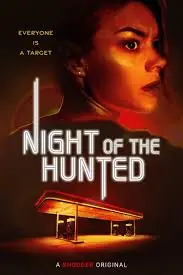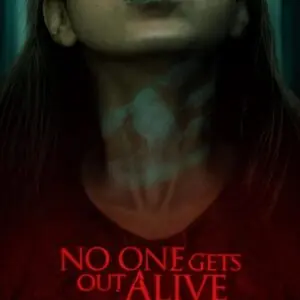Alejandro G. Iñárritu’s The Revenant (2015) is a stark, meditative, and at times punishing film that explores the limits of human endurance, the raw brutality of nature, and the driving force of revenge. Loosely based on the real-life experiences of 19th-century frontiersman Hugh Glass, the film delivers an emotionally and physically visceral cinematic experience, brought to life through stunning cinematography, immersive sound design, and an Oscar-winning performance from Leonardo DiCaprio.
Plot and Storytelling
Set in the 1820s American wilderness, The Revenant follows Hugh Glass (Leonardo DiCaprio), a skilled tracker guiding a group of fur trappers through treacherous territory. After being savagely mauled by a grizzly bear and left for dead by members of his own hunting party—most notably the treacherous John Fitzgerald (Tom Hardy)—Glass embarks on an arduous journey across a frozen, hostile landscape to survive and seek justice.
The plot, though simple on the surface, functions more as a vessel for an existential exploration of man versus nature, life versus death, and revenge versus redemption. Iñárritu and co-writer Mark L. Smith construct the story with minimal dialogue, allowing the physical performances, the landscape, and the camerawork to carry much of the emotional weight.
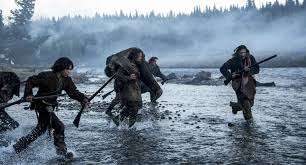
Leonardo DiCaprio’s Performance
Leonardo DiCaprio’s portrayal of Hugh Glass is the film’s emotional anchor. It is a performance built not on eloquent dialogue or overt charisma, but on grunts, gasps, pain, and sheer determination. DiCaprio immerses himself completely, enduring freezing rivers, eating raw bison liver, and crawling through snow and mud. It’s an intensely physical role, and DiCaprio delivers a performance that strips away ego, laying bare the raw essence of human survival.
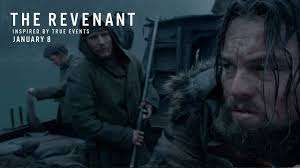
This role finally won him his long-anticipated Oscar, and rightly so. DiCaprio doesn’t just act the part of a man clinging to life—he lives it. His commitment is unwavering, and through Glass’s pain, fear, and stubborn will, the viewer feels the weight of every step in his harrowing journey.
Tom Hardy and the Supporting Cast
While DiCaprio is the focal point, Tom Hardy’s performance as John Fitzgerald provides a compelling and gritty counterpoint. Hardy plays Fitzgerald as a pragmatic, self-serving survivalist whose choices—though brutal—are often motivated by a different kind of realism. Hardy’s mumbling, hardened delivery gives the character a cruel authenticity that adds tension to every scene he’s in. He’s not a traditional villain, but rather a reflection of another path one might take in a world so brutal and unforgiving.
Domhnall Gleeson as Captain Henry and Will Poulter as the morally conflicted Bridger round out a strong supporting cast. Both actors bring a sense of grounded realism to their roles, highlighting the moral complexities of loyalty and leadership under pressure.
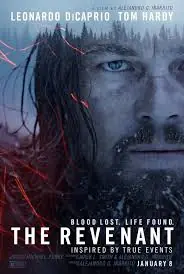
Cinematography and Visual Power
Perhaps the most talked-about element of The Revenant—aside from DiCaprio’s performance—is Emmanuel Lubezki’s masterful cinematography. Shot entirely using natural light, the film’s visual style is breathtaking. Lubezki, already acclaimed for his work on Gravity and Birdman, crafts a world that is both stunning and savage. The cold wilderness is not just a backdrop but a character in itself—unforgiving, immense, and indifferent to human suffering.
Long takes and wide-angle shots immerse the audience in the environment, while the camera’s fluid movement often places the viewer directly in the action. The infamous bear attack scene is a technical and emotional marvel—tense, horrifying, and unrelentingly real. It feels less like a movie scene and more like a traumatic experience, an example of how camera work can deepen the impact of storytelling.
Themes and Symbolism
At its core, The Revenant is a film about survival—but survival for what purpose? For Glass, it begins with revenge, but as his journey progresses, the film suggests that vengeance alone may not be enough to sustain the will to live. Flashbacks to his murdered Pawnee wife and his lost son offer glimpses into a man who has already suffered unimaginable loss. These scenes are intercut with spiritual and symbolic imagery, including fire, water, and rebirth, hinting at themes of reincarnation, ancestral memory, and the cyclical nature of violence.
Nature itself becomes a metaphor for life’s indifference. Glass must battle not only Fitzgerald, but also the cold, starvation, infection, and wild animals. The line between man and beast becomes increasingly blurred. Who is more savage—the bear, the treacherous Fitzgerald, or the society that has pushed these men into the wilderness in search of profit?
Additionally, the film subtly addresses the violence of colonization. Native American tribes are shown as victims of displacement and brutality, yet their portrayal is not one-dimensional. The Arikara chief’s search for his kidnapped daughter adds depth and humanity to a narrative often told solely from a colonial perspective.
Direction and Atmosphere
Alejandro G. Iñárritu brings a hypnotic, immersive vision to The Revenant. Known for his innovative storytelling and long takes, Iñárritu trades the theatricality of Birdman for a more primal, elemental experience. He leans into silence, mood, and visual storytelling, trusting his actors and cinematographer to convey the inner turmoil of his characters.
The sound design complements the visuals perfectly—howling winds, cracking ice, labored breaths, and the eerie silence of snow-covered forests create a soundscape that is both beautiful and unsettling. The minimalist score by Ryuichi Sakamoto and Alva Noto enhances the film’s spiritual tone without overpowering the natural sound of the environment.
Criticisms and Pacing
Some critics argue that The Revenant is overly long and indulgent, and there’s some truth to this. At 156 minutes, the film is deliberately paced, and its sparse dialogue and repetitive suffering may test the patience of some viewers. The meditative tone may come across as self-important or overly grim. However, for those willing to engage with its rhythm, The Revenant offers a profound cinematic experience.
Conclusion
The Revenant is not a film for everyone—it is brutal, slow-burning, and unrelentingly intense. But it is also a deeply cinematic achievement, a work of art that pushes the boundaries of what film can capture. With a career-defining performance from Leonardo DiCaprio, stunning visuals by Emmanuel Lubezki, and a raw, elemental story of survival, The Revenant is a landmark film of the 2010s.
It forces the viewer to confront nature’s indifference, humanity’s cruelty, and the resilience of the human spirit. More than just a revenge tale, The Revenant is a meditation on life, death, and the wildness that exists within and around us.
Rating: 9/10

